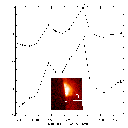Pointy-headed loops
Science Nugget: November 3, 2000
Introduction
Reading these Nuggets, one might get the idea that we're crazy about
"cusps", those pointy-shaped loops that are often seen in X-ray images of
solar flares. And perhaps we are a bit crazy about them: after all, there
are more than 30 references to cusps in the Nuggets to date. (Don't
believe me? Try the Search function on the Nuggets homepage!)
Why we care about cusps
The reason we spend so much time looking at cusped loops is simultaneously
simple and complicated: we like them because they tell us about the
magnetic field. The plasma in the solar corona shows us the
connectivity of the magnetic field, and a pointy shape suggests that the
field lines in that region are possibly open to space (or have been recently
opened and re-closed). If so, then plasma
can travel along those lines into space, possibly affecting the Earth.
A few studies have therefore used the appearance of a cusped loop as a
signature that an eruption has occurred, even if the ejection of material
isn't directly observed (e.g.,
Canfield, Hudson, and McKenzie). A more complete discussion about the
appropriateness of this "proxy CME signature" is found in
this
previous nugget.
Brief reminder of what we're talking about: the beautiful image below shows a nice
example of a cusp from last March.

But that's not all!
Among the many properties of magnetic fields, one is particularly important in
this context: magnetic field lines must be closed. Put another way, there are no
ends to a magnetic field line. So when we say that a field is "open to space",
what we mean is that the field has been stretched so far above the Sun that it
effectively doesn't connect back to the Sun. Thus, any plasma that flows
outward along such field lines can be swept further out by the solar wind, and
leave the Sun altogether.
But fields that are oppositely directed may come near each other, and a
"reconnection" can occur. See
this cartoon for a sketch of the scenario. The reconnected field lines
connect to the Sun on both ends, and have cusps at their tops. At this position,
the plasma is superheated (so the theory goes), due to shocks forming in the retraction of these stretched
magnetic field lines. Measurement of this, in fact, is one of the earlier results
from Yohkoh (Tsuneta, et al., 1992 PASJ, 44, 63). For some more recent questions
about cusps and how they may behave during flares, see previous nuggets for
June 9,
2000 and July 21,
2000.
So What's New?
In the image above, as well as in the previous nuggets,
one can clearly see the completely formed and well illuminated. Last week, SXT
images showed us an unusual feature, the apparent brightening of a cusp. Of
course, we knew it happened, but it's nice to see it in action. In the movie
below, one can see an active region beyond the west
limb, and the cusp filling in above it. The movie spans 32 minutes on
19-OCT-00, showing 15 images between 17:03 and 17:35 UT. (Please pardon the
jitter in the image alignment -- these data are still fresh.)

Java Script movie -- MPEG movie
On a solar scale, this is not a large event. The GOES spacecraft, which
records the total amount of X-rays from the whole Sun, shows only a tiny and insignificant rise in the X-ray
background. But light curves from the SXT movie, wherein we can measure
the brightness in a specific region, demonstrate the filling in of the
upper part of the structure. The two light curves below are measured from
the SXT images, in the regions marked "A" and "B" in the inset image.

What Makes This Special
What we're seeing here is plasma filling in from below -- it does not appear to be
"thrown" upwards like the ejecta in some
flares. The cusps
are believed to be filled in by plasma rising up from the lower atmosphere, in a
process called "chromospheric evaporation", or equally "chromospheric ablation".
As a result of the reconnection of the magnetic field lines, a great deal of
energy is conducted down to the chromosphere; this then heats the chromospheric
plasma, which injects itself into the just-formed loops.
There is a possible link to the spiky
arcades, in which tall magnetic structures are filled with plasma, possibly
from below. In fact, one tentative explanation for the spikey arcades would have
them nothing more than tall skinny post-eruption cusps.
Sideline: is it a "cusp", or a "jet"?
You willl find lots of images of X-ray jets in these Nuggets.
Maybe the argument is entirely semantic, but since this is clearly an
example of plasma filling a pre-existing magnetic structure, some could say it
might
better be classified as a jet, rather than a cusp. Ordinarily, however,
jets brighten on a shorter time scale than this event. Is there a real
difference? Yes -- cusps are taken as a signature that an eruption has
(possibly) occurred, because it indicates that magnetic field lines have
been opened to space and subsequently re-closed. Jets, on the other hand,
can be thought of as events wherein million-degree plasma is channeled
along a nearly linear conduit formed by magnetic field lines -- but these
field lines need not be open to space at any time. But don't take my word
for it -- have a look at the previous nuggets on jets, and decide for
yourself!
November 3, 2000
David McKenzie
<mckenzie@isass0.solar.isas.ac.jp>


